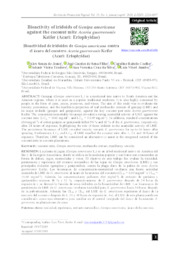Bioactivity of iridoids of Genipa americana against the coconut mite Aceria guerreronis Keifer (Acari: Eriophyidae).
Bioactivity of iridoids of Genipa americana against the coconut mite Aceria guerreronis Keifer (Acari: Eriophyidae).
Author(s): JESUS, A. S. de; SENA FILHO, J. G. de; COELHO, C. R.; TEODORO, A. V.; SILVA, A. V. C. da; JUMBO, L. V.
Summary: Genipap (Genipa americana L.) is a medicinal tree native to South America and the Amazon regions, where it is used as a popular traditional medicine. It is also highly consumed by people in the form of jams, juices, preserves, and wines. The aim of this study was to evaluate the toxicity, persistence, and the repellence properties of leaf methanolic extracts of genipap (LME) and its major iridoids (genipin and geniposide), against the key coconut pest mite Aceria guerreronis Keifer. The concentration-mortality bioassays revealed a strong acaricidal activity of LME against the coconut mite (LC50 = 0.60 mg.ml-1; and LC90 = 16.69 mg.ml-1). In addition, standard concentrations (0.6 mg.ml-1) of either genipin or geniposide killed 50 % and 62 % of the A. guerreronis, respectively, after 24 hours of exposure, highlighting the role of these iridoids in the acaricidal activity of LME. The persistence bioassays of LME revealed toxicity towards A. guerreronis for up to 36 hours after spraying. Furthermore, LC50 and LC90 of LME repelled the coconut mite after 1, 24, and 48 hours of exposure. Therefore, LME can be considered an alternative to assist in the integrated control of the coconut mite in coconut plantations.
Publication year: 2020
Types of publication: Journal article
Keywords: Biological control, Coco, Coconuts, Controle Biológico, Genipa, Genipa Americana, Praga, Praga de Planta
Observation
Some of Embrapa's publications are published as ePub files. To read them, use or download one of the following free software options to your computer or mobile device. Android: Google Play Books; IOS: iBooks; Windows and Linux: Calibre.
Access other publications
Access the Agricultural Research Database (BDPA) to consult Embrapa's full library collection and records.
Visit Embrapa Bookstore to purchase books and other publications sold by Embrapa.

